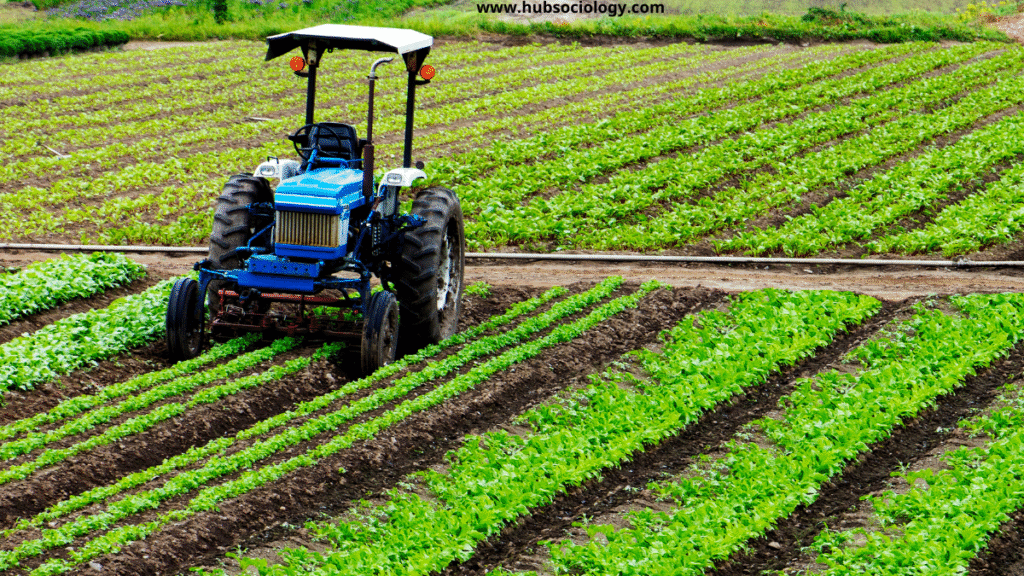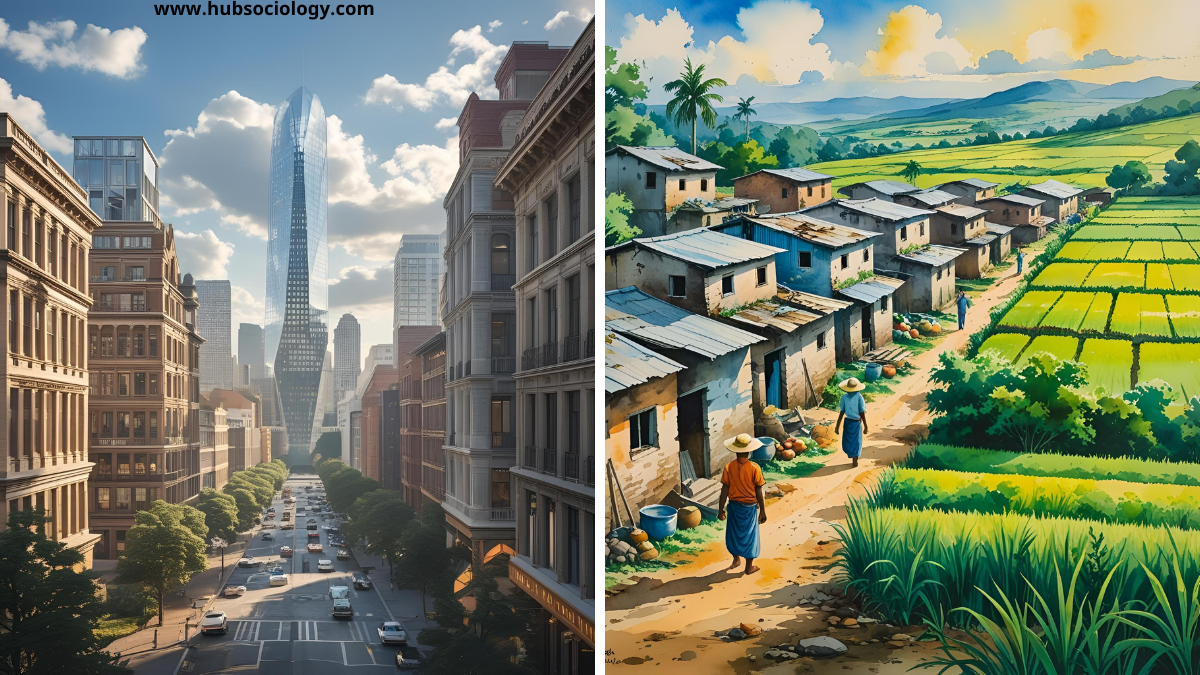Introduction on Rural-Urban Differences
The distinction between rural and urban societies has been a central theme in sociology since its inception. Sociologists like Ferdinand Tönnies, Emile Durkheim, and Robert Redfield have explored how patterns of life, social structures, and values differ between rural and urban settings. While both are integral parts of the same national and cultural framework, they exhibit contrasting characteristics in terms of social relations, occupations, lifestyle, and cultural values.
The study of rural-urban differences helps in understanding social change, modernization, and the dynamics of development in contemporary societies.

Table of Contents
Meaning and Nature of Rural-Urban Differences
The term rural refers to areas characterized by agricultural activities, small settlements, and close-knit communities, whereas urban refers to cities and towns marked by industrial and service-based economies, large populations, and complex social structures. The distinction is not merely geographical but sociological, involving differences in modes of living, occupational patterns, social relationships, and attitudes.
Sociologically, rural society is often described as Gemeinschaft (community) by Tönnies—based on personal, emotional, and traditional bonds—while urban society is seen as Gesellschaft (association), characterized by impersonal, contractual, and rational relationships. Thus, rural-urban differences represent two distinct types of social organization shaped by economic, demographic, and cultural forces.
1. Population and Density
One of the fundamental differences lies in population size and density. Rural areas are sparsely populated, with people living in dispersed settlements. The small population fosters familiarity and intimacy among members, resulting in strong community bonds. In contrast, urban areas have a dense and heterogeneous population. People often live in apartments, and their interactions are functional and temporary. The anonymity and impersonality of city life, as noted by Georg Simmel in The Metropolis and Mental Life, contribute to a sense of isolation despite physical proximity.
2. Occupation and Economy
The economic base of rural and urban societies differs markedly. The rural economy primarily depends on agriculture, animal husbandry, fishing, and related activities. It is often seasonal and influenced by natural factors like rainfall and soil fertility. Urban economies, on the other hand, are industrial and service-oriented, with diverse occupations ranging from manufacturing to information technology. Urban life offers multiple opportunities for specialization, professional growth, and economic mobility, while rural areas often face unemployment, underemployment, and dependency on land.
3. Social Structure and Relationships
In rural areas, the social structure is simple and homogeneous. Social relations are based on kinship, caste, and community. People know each other personally, and social control is informal, exercised through customs, traditions, and social approval or disapproval. In urban society, relationships are impersonal, contractual, and utilitarian. The social structure is complex, with diverse social classes, ethnic groups, and occupational categories. Social control is largely formal, maintained through laws, police, and bureaucratic institutions.
Tönnies’ concept of Gemeinschaft and Gesellschaft aptly captures this difference—rural life embodies close emotional bonds and collective consciousness, while urban life promotes individualism and rationality.
4. Social Mobility and Change
Rural society is relatively stable and slow to change. Traditions play a significant role in determining social behavior and status. Occupations and social positions are often hereditary, and mobility is limited. In contrast, urban society is dynamic and open to change. Education, industrialization, and market forces facilitate vertical and horizontal mobility. Urban dwellers frequently change jobs, locations, and social circles, leading to greater fluidity in the social order.
This difference has profound implications for modernization and development. Urban settings encourage innovation, experimentation, and acceptance of new ideas, while rural societies tend to be conservative and resistant to rapid transformation.
5. Lifestyle and Culture
Cultural patterns differ sharply between rural and urban areas. Rural life is simple, guided by local traditions, folk art, and religious rituals. Festivals, marriages, and social gatherings are community-oriented and emphasize collective participation. Urban culture, in contrast, is cosmopolitan, influenced by media, technology, and globalization. Individualism, consumerism, and materialism dominate urban life. People often lead a fast-paced life, balancing work and personal aspirations.

Durkheim’s concept of mechanical and organic solidarity is relevant here. Rural societies exhibit mechanical solidarity, where individuals are bound by shared beliefs and values. Urban societies display organic solidarity, where social cohesion arises from interdependence among specialized roles and institutions.
6. Family and Kinship Patterns
The family structure also differs significantly. In rural areas, the joint family system prevails, and kinship ties are strong. Elders play a vital role in decision-making, and social norms regulate marriage, property, and inheritance. In urban society, the nuclear family is dominant, and individuals enjoy greater autonomy. Kinship ties weaken as people migrate for jobs and education. The pace of life, urban housing patterns, and women’s employment contribute to the shrinking of family size and the redefinition of gender roles.
7. Education and Communication
Rural education systems often suffer from limited infrastructure, fewer schools, and traditional methods of teaching. Literacy rates are generally lower than in urban areas. Urban areas provide better access to educational institutions, libraries, and digital platforms. Communication channels in rural areas are informal—word of mouth, community meetings, and local leaders—whereas urban communication is modern and mediated by technology such as newspapers, television, and the internet. This communication gap affects awareness, political participation, and social development.
8. Social Problems
Rural and urban societies face different sets of social problems. Rural areas struggle with poverty, unemployment, lack of healthcare, caste discrimination, and migration. Urban areas face challenges such as overcrowding, pollution, housing shortages, crime, and social alienation. Migration from rural to urban areas often creates slums and informal settlements, leading to problems of sanitation, infrastructure, and inequality. Sociologists view these as outcomes of uneven development and the transition from agrarian to industrial economies.
9. Political and Administrative Organization
In rural areas, political participation tends to be limited, often influenced by traditional hierarchies and local elites. The Panchayati Raj system in India has aimed to democratize rural governance but still faces challenges of caste and gender inequality. Urban areas have more organized political institutions, civic bodies, and active citizen participation. Urban residents are generally more aware of their rights and more likely to engage in movements and public debates.
10. Attitudes and Values
The value orientation in rural society emphasizes conformity, respect for tradition, and collective welfare. People derive identity from community membership and follow established norms. Urban society, on the other hand, promotes rationality, efficiency, and achievement. Individual success, career advancement, and material comfort are valued over traditional obligations. This cultural shift reflects broader processes of modernization and globalization.
Rural-Urban Continuum
Contemporary sociologists argue that rural and urban societies should not be seen as two separate entities but as parts of a continuum. Modern communication, transportation, and technology have blurred the boundaries between them. Urban influences such as media, education, and consumer goods have penetrated rural life, while urban dwellers seek rural tranquility through tourism, organic farming, and suburban living. The rural-urban continuum thus represents the gradual blending of lifestyles and values across space.
Conclusion on Rural-Urban Differences

The rural-urban differences, while distinct, are not absolute. They represent two ends of a social continuum shaped by economic, cultural, and technological forces. Understanding these differences sociologically allows us to appreciate how modernization, urbanization, and globalization transform traditional societies. In India, rural and urban sectors coexist and depend on each other—agriculture sustains the cities, while urban centers drive innovation, industry, and education. Bridging the rural-urban divide through balanced development, social inclusion, and sustainable policies remains a major challenge for modern societies.
Do you like this this Article ? You Can follow as on :-
Facebook – https://www.facebook.com/hubsociology
Whatsapp Channel – https://whatsapp.com/channel/0029Vb6D8vGKWEKpJpu5QP0O
Gmail – hubsociology@gmail.com
Topic-Related Questions on Rural-Urban Differences
5 Marks on Rural-Urban Differences
- Define rural and urban society in sociological terms.
- Mention any two major differences between rural and urban life.
10 Marks on Rural-Urban Differences
- Explain Tönnies’ concept of Gemeinschaft and Gesellschaft in the context of rural-urban differences.
- Discuss the role of occupation and social relationships in distinguishing rural from urban society.
15 Marks on Rural-Urban Differences
- Examine the sociological differences between rural and urban societies with suitable examples.
- Critically analyze the idea of the rural-urban continuum in the context of social change in India.
